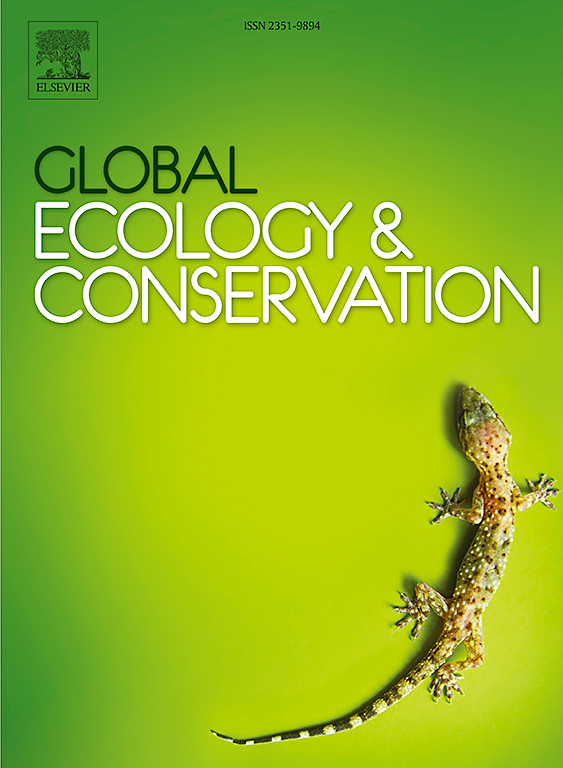Population and habitat assessments for conservation: Comparing national strategies for Canadian boreal caribou and Norwegian wild reindeer
IF 3.4
2区 环境科学与生态学
Q1 BIODIVERSITY CONSERVATION
引用次数: 0
Abstract
Habitat loss and fragmentation are major threats to biodiversity. While essential, demographic data alone may be insufficient to rapidly detect habitat-driven population declines and identify efficient management actions. This study explores how conservation strategies can use and integrate demographic and environmental information to detect, monitor and counter population declines. By comparing two extensive conservation strategies for Rangifer tarandus in Canada and Norway, we draw key insights for more comprehensive and actionable strategies. Conservation strategies often use multicriteria approaches combining population and habitat metrics, but seldom succeed in formally integrating these through a causal understanding of habitat-population relationships. The Canadian strategy probabilistically assesses the viability of boreal caribou populations both through direct population modeling, and by statistically linking habitat disturbance to recruitment - thus indirectly capturing habitat-mediated changes in predator-prey dynamics and their consequences on caribou vital rates. The Norwegian strategy develops an expert-based approach to score the quality of wild reindeer populations by combining assessments of habitat quality, connectivity, demography, genetics and health. While the Norwegian assessment is more locally anchored and explores a wider range of drivers, the Canadian one is more targeted and provides a statistical conversion rate between habitat and population metrics. Both assessments serve as a basis for follow-up management actions. This study highlights the need to intensify research to quantify cumulative anthropogenic impacts on the loss of functionally connected habitat, and their consequences on population viability. This would enable early-warning systems for assessing population declines, and help shape more targeted prevention, mitigation and restoration actions.
保护的人口和栖息地评估:比较加拿大北方驯鹿和挪威野生驯鹿的国家战略
栖息地丧失和破碎化是生物多样性的主要威胁。人口数据固然重要,但可能不足以迅速发现由生境引起的人口下降和确定有效的管理行动。本研究探讨了保护策略如何利用和整合人口和环境信息来检测、监测和应对人口下降。通过比较加拿大和挪威的两种广泛的保护策略,我们得出了更全面和可操作的策略的关键见解。保护策略通常使用结合种群和栖息地指标的多标准方法,但很少成功地通过对栖息地-种群关系的因果理解将这些标准正式整合起来。加拿大的策略是通过直接的种群模型,以及通过统计将栖息地干扰与补充联系起来,从而间接地捕捉栖息地介导的捕食者-猎物动态变化及其对北美驯鹿生命率的影响,对北方驯鹿种群的生存能力进行概率评估。挪威的战略制定了一种以专家为基础的方法,通过综合评估栖息地质量、连通性、人口统计学、遗传学和健康状况,对野生驯鹿种群的质量进行评分。挪威的评估更立足于当地,探讨了更广泛的驱动因素,而加拿大的评估更有针对性,并提供了栖息地和人口指标之间的统计转换率。这两项评估都是后续管理行动的基础。本研究强调有必要加强研究,量化人类活动对功能连接栖息地丧失的累积影响及其对种群生存能力的影响。这将使早期预警系统能够评估人口下降,并有助于制定更有针对性的预防、缓解和恢复行动。
本文章由计算机程序翻译,如有差异,请以英文原文为准。
求助全文
约1分钟内获得全文
求助全文
来源期刊

Global Ecology and Conservation
Agricultural and Biological Sciences-Ecology, Evolution, Behavior and Systematics
CiteScore
8.10
自引率
5.00%
发文量
346
审稿时长
83 days
期刊介绍:
Global Ecology and Conservation is a peer-reviewed, open-access journal covering all sub-disciplines of ecological and conservation science: from theory to practice, from molecules to ecosystems, from regional to global. The fields covered include: organismal, population, community, and ecosystem ecology; physiological, evolutionary, and behavioral ecology; and conservation science.
 求助内容:
求助内容: 应助结果提醒方式:
应助结果提醒方式:


